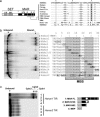Birth of a chimeric primate gene by capture of the transposase gene from a mobile element
- PMID: 16672366
- PMCID: PMC1472436
- DOI: 10.1073/pnas.0601161103
Birth of a chimeric primate gene by capture of the transposase gene from a mobile element
Abstract
The emergence of new genes and functions is of central importance to the evolution of species. The contribution of various types of duplications to genetic innovation has been extensively investigated. Less understood is the creation of new genes by recycling of coding material from selfish mobile genetic elements. To investigate this process, we reconstructed the evolutionary history of SETMAR, a new primate chimeric gene resulting from fusion of a SET histone methyltransferase gene to the transposase gene of a mobile element. We show that the transposase gene was recruited as part of SETMAR 40-58 million years ago, after the insertion of an Hsmar1 transposon downstream of a preexisting SET gene, followed by the de novo exonization of previously noncoding sequence and the creation of a new intron. The original structure of the fusion gene is conserved in all anthropoid lineages, but only the N-terminal half of the transposase is evolving under strong purifying selection. In vitro assays show that this region contains a DNA-binding domain that has preserved its ancestral binding specificity for a 19-bp motif located within the terminal-inverted repeats of Hsmar1 transposons and their derivatives. The presence of these transposons in the human genome constitutes a potential reservoir of approximately 1,500 perfect or nearly perfect SETMAR-binding sites. Our results not only provide insight into the conditions required for a successful gene fusion, but they also suggest a mechanism by which the circuitry underlying complex regulatory networks may be rapidly established.
Conflict of interest statement
Conflict of interest statement: No conflicts declared.
Figures



Comment in
-
Evolutionary tinkering with transposable elements.Proc Natl Acad Sci U S A. 2006 May 23;103(21):7941-2. doi: 10.1073/pnas.0602656103. Epub 2006 May 16. Proc Natl Acad Sci U S A. 2006. PMID: 16705033 Free PMC article. No abstract available.
References
Publication types
MeSH terms
Substances
Associated data
- Actions
- Actions
- Actions
- Actions
- Actions
- Actions
- Actions
- Actions
- Actions
- Actions
- Actions
- Actions
- Actions
- Actions
- Actions
- Actions
Grants and funding
LinkOut - more resources
Full Text Sources
Other Literature Sources
Molecular Biology Databases

